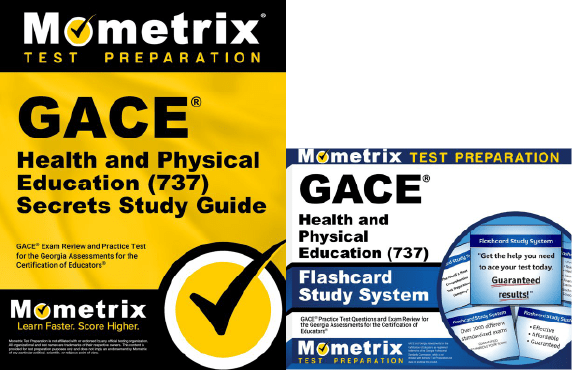If you need help studying for the GACE Health and Physical Education test or just want some more information about what the test is like, you’ve come to the right place!
Click below to take a free GACE Health and Physical Education practice test!
What’s on the Test?
The GACE Health and Physical Education (737) test contains 120 multiple-choice questions and is timed at 3 hours.
The exam is split into five testlets, which are taken in separate testing sessions (but can be taken on the same day if you’d like).
Physical Literacy and Movement Skills (326)
30 questions | 45 minutes
- Motor development
- Physical literacy
- Principles, techniques, skills, activities, organizational strategies, and safety practices for various activities and challenges
Physical Activity (372)
20 questions | 30 minutes
- Components of both health-related and skill-related fitness
- Principles and procedures for developing healthy habits and lifelong physical activity
Health Promotion and Disease Prevention (507)
20 questions | 30 minutes
- Supporting students’ physical, mental, emotional, and social health
- Social determinants of health
- Personal care and hygiene
- Communicable, noncommunicable, and chronic disease prevention
- Interpreting nutritional facts and labels
- Body systems’ adaptation to physical activity
Skills for Enhancing Health and Reducing Risks (508)
30 questions | 45 minutes
- Preventing and reducing health risks
- Factors that affect mental, emotional, and social health
- Promoting healthy relationships and communication
- Enhancing health using safety, goal-setting, decision-making, conflict-resolution, and advocacy
Health and Physical Education Program (509)
20 questions | 30 minutes
- Various influences on health behaviors
- Health literacy
- Locating and evaluating health information services
- Curriculum, instruction, assessment, and professionalism
How to Register
To get started with the registration process, you’ll need to create a MyPSC account on the GaPSC website. You should receive a Georgia Certification ID (GA CERT ID) during this process, which you’ll use for identification throughout the registration and testing process.
The next step is to create an Evaluation Systems GACE account. This account will allow you to register for the exam and pay the testing fee(s).
How the Exam is Scored
The GACE Health and Physical Education test is scored using a scaled scoring method. Here’s how it works:
Scaled Scoring
For every question you answer correctly, you get one point added to your raw score. At the end of the test, your final raw score will be converted to a scaled score.
The reason your raw score is converted to a scaled score is because everyone that takes the test is given a slightly different set of questions. Since everyone has a different arrangement of questions, and because some questions are harder than others, converting your raw score to a scaled score ensures a more even playing field.
Retaking the Exam
If you don’t get the score you want on your first try, that’s okay! You can take the exam again after a mandatory 30-day waiting period.
FAQs
How many questions are on the GACE Health and Physical Education exam?
The exam contains 120 questions.
What is the time limit for the GACE Health and Physical Education exam?
The exam is timed at 3 hours.
What is the passing score for the GACE Health and Physical Education exam?
You’ll need to get a final score of at least 220 to pass the exam.
How much does the GACE Health and Physical Education exam cost?
The exam fee is $169 for the full exam.
Mometrix Test Preparation is not affiliated with or endorsed by any official testing organization. All organizational and test names are trademarks of their respective owners.



 GACE Study Guide
GACE Study Guide GACE Flashcards
GACE Flashcards